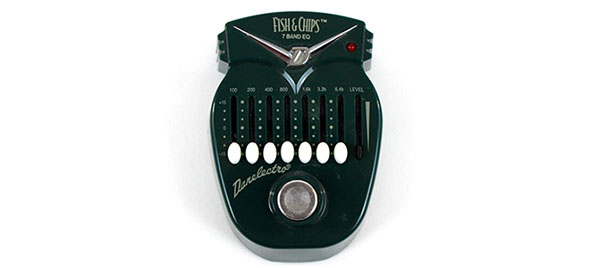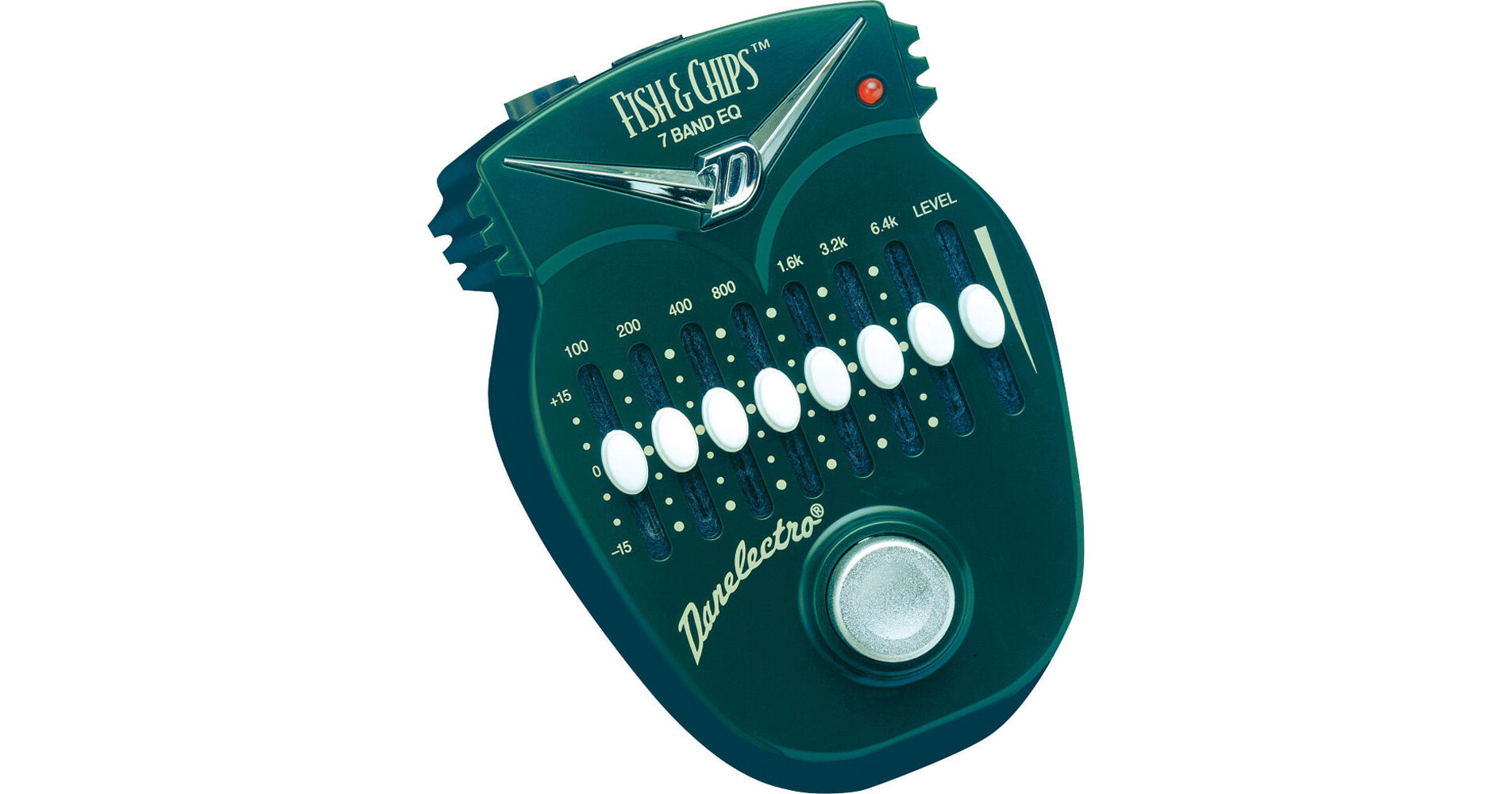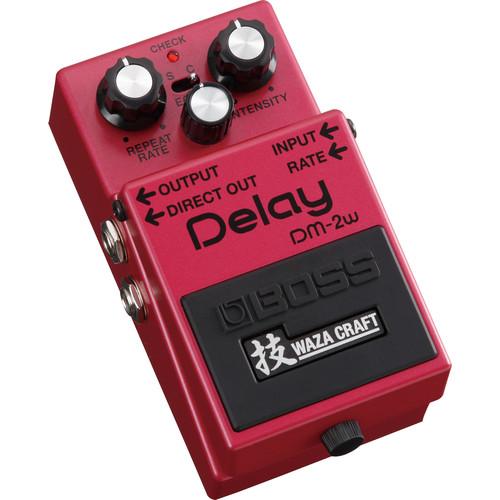1947 - 2020
Nathan Daniel started making Danelectro guitars in 1954 out of Masonite and plywood and featuring the signature lipstick tube pickup. Danos like Jimmy Page’s 59-DC were originally budget guitars, and many were distributed under the name Silvertone & Airline in different department stores. Starting in the 90s, the Danelectro name was reused a few times with reissues of classic modes like the U-2, Doubleneck, and Longhorn along with new pedals like the Cool Cat.
This website cannot be reproduced in any manner, whatsoever, without permission. Some Danelectro guitar components are reproduced under license of U.S. Trademark Number 2,411,842. Danelectro sometimes provides free products to beta testers who may later express their views on these products on the web or in print. Prices and specs subject to. An effective 7-band graphic EQ pedal, the Danelectro Fish & Chips is perfect for stage or studio use. 7 band sliders and a volume slider each provide a boost/cut of ±15dB. Noise-free with buffered bypass. The Fish n' Chips EQ, however, could even handle the amp's loop. I was using an amp at the time that had a nearly line-level loop, it did not get along with a lot of pedals, ANY of the other Dan-o pedals, but the Fish n' Chips could take the signal. According to the manual it’s literally a class A transformer in a stomp box. I love it, I would just hate for you to be disappointed. The Danelectro Fish & Chips 7-band EQ pedal is also an excellent buy. 2 points 1 year ago. I love my fab chorus!
The very first Danelectro guitars were built beginning in 1954. For many teen-agers, this was their first instrument. Brand new, the cheapest models cost as little as $69.00. Many were sold by Sears, under the label 'Silvertone.' The most popular models came in a case with a built-in amplifier.
Today, that $69.00 guitar, unmodified, and in excellent condition could cost you $500.00 or more. Because they were so cheap, many Danelectros were thrown away, damaged or altered along the way.
Constructed simply of wood, vinyl, masonite and Formica, Danelectros used 'lipstick tube' metal pick-ups that were literally purchased from a lipstick-tube manufacturer. The guitars were made simply, with no pearl adornments or expensive wood.
Danelectro Fish And Chips Pedal

Professional guitarists have driven up the value of authentic Danelectros because they cherish the instrument's unique sound and look. They have a bell-like tone and a very clean sound. But non-professionals, many of them nostalgic baby boomers, are also entranced. There's the show-off, cool aspect to owning one. And the rareness. They have a sound, look and color all their own.
Many of today's top rock guitarists own a Dano. They play them on stage and use them in the studio. Joe Perry of Aerosmith once offered someone $30,000 for an entire Danelectro collection!
Guitars designed by Nathan Daniel (1912-1994) never reached the pantheon of instruments made by Fender, Gibson, and Martin. But in their own way they were no less influential, their low price tag making them readily available to the masses. Cost cutting was achieved through materials and construction. As with this 3012 'short horn' model in 'bronze' finish, the top and back of many Danelectro instruments were made from one-eighth-inch Masonite glued over a poplar framework, and covered over with a painted finish (including trendy colors like fuchsia and peach).

Before Nathan Daniel started the Danelectro company in 1947, he made amplifiers for Epiphone from 1934 to 1946. Epiphone wanted Daniel to make amps for them exclusively, but he preferred to stay independent. Instead he founded the Danelectro company in 1947 and started making amplifiers for Montgomery Ward. By 1948 Daniel expanded and became the exclusive guitar amplifier producer for Sears & Roebuck. At the same time he was also supplying other jobbers such as Targ & Dinner of Chicago.
In the fall of 1954, Daniel started production of solidbody guitars for Sears, under the Silvertone name. He also produced the same guitars under the Danelectro name, sold to other jobbers. These early models didn't have truss rods but had a 3/4' square aluminum tube beginning at the peghead and through the body to the bridge. The bodies were constructed of solid Poplar wood. The Silvertone models were covered with a dark maroon vinyl covering, while the Danelectro models were covered in a whitish tweed material. Both lines came with either 1 or 2 pickups, concealed under a baked melamine pickguard. Concentric stacked tone and volume knobs were used on the two pickup models only. Notably, when both pickups were used together, the tone was much stronger. This was due to wiring the pickups in series, instead of parallel like most other maker's two pickup guitars.
Danelectro's trademark was the masonite construction of the guitar bodies. The bodies were hollow, built around a wooden frame. The bridge was screwed into an internal wooden block that connected the top and back of the body. In earlier models, a piece of wood runs from the neck pocket to the bridge, while later models contain less internal structure.
Danelectro's well-known 'lipstick' single-coil pickups are a big part of why these guitars sound so good. These are constructed around a single alnico bar magnet, wound to a relatively low (4.75k) resistance, and housed in an actual surplus lipstick tube.
Single-pickup long-scale Danelectro guitars originally came equipped with an ingenious three-way tone switch. Like many 50's single-pickup designs, this was intended for quick transitions between rhythm and lead tones, such as the Fender Esquire concept. In the lower switch position, the tone control (which was located where you would expect the volume control to be, closer to the bridge) functions normally. In the middle position, the tone control is bypassed entirely. In the top position, the tone control rolls off lows instead of highs, creating a sound similar to that of a bridge pickup.
On guitars with more than one pickup, Danelectro used 'concentric' stacked knobs. In order to save money, the same generic three-way toggle switch found in the single-pickup guitars was used as a pickup selector switch. This is the real reason Danelectro guitars had their pickups wired in series, producing a big punchy sound with more output and midrange than individual pickup settings and eliminating hum. Parallel wiring (as used by virtually all other manufacturers) would have required a slightly more expensive switch!

By the fall of 1956, Daniel started making the Silvertone and Danelectro lines using the standard Dano materials: a Poplar wood frame (that comprised the sides, neck and bridge block of the guitar), stapled together and covered with 3/8' thick masonite. The top and back was painted, but the sides were covered in a vinyl material to hide the unpainted poplar wood frame. Also the now infamous 'Lipstick tube' pickups were used. These pickups had an alnico bar magnet and coil measuring 4.75k ohms wrapped in brown vinyl tape. The pickup guts were placed inside surplus, chrome plated, lipstick tubes. These pickups were actually the same as previously used and hidden beneath the pickguard. Just now they were adorned in lipstick tubes and mounted in cutouts in the masonite body. Construction methods stayed this way for most models throughout Danelectro's history.


In 1966 Nathan Daniel sold the Danelectro company to MCA but remained with the company. Later in the 60's he moved to Hawaii to pursue another passion... building sailboats.
Danelectro Fish And Chips Manual
In 1967 the Coral line of guitars was introduced. At the time, Danelectro sold about 85% of it's products to Sears so MCA started the Coral line to sell to other distributors. The difference was the Coral hollow bodies (only) were manufactured in Japan. All other Coral parts were made in the New Jersey Danelectro plant. All Silvertones and Danelectros were made entirely in the U.S.
…MORE DANELECTRO HISTORY, COMING SOON!